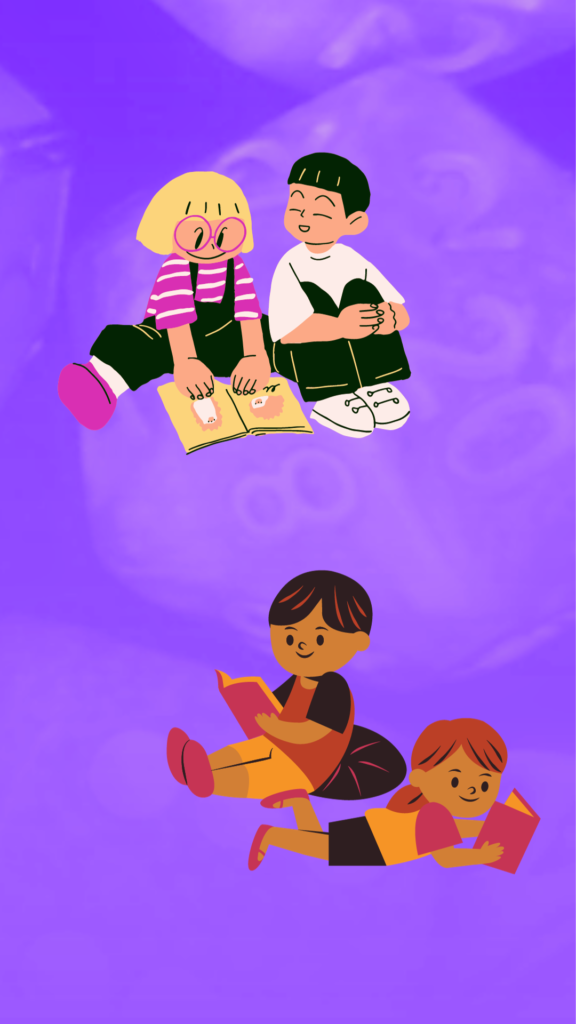Tips and Tricks: Using TTRPGs to get kids reading!
Jump to:
- Start at an accessible level
- Reading as a tool to play (and not just work)
- Social accountability and support to practice
- Extending reading beyond the game
Start at a reading level that is accessible to your players

Throughout multiple articles on this site, I emphasize the importance of making sure the game you’re using is accessible to your players’ math, comprehension, reading, etc skills so there’s minimal barriers to starting the game and having fun.
This is SO important.
There is something to be said for introducing a bit of a challenge to learn. You sometimes want the reading level to be slightly higher than the player’s current capability so that they can grow. However, don’t take that too far, especially if you are using this intentionally to foster a love of reading. You don’t want it to get too frustrating or be a chore. Besides, once they’re hooked, you always increase the difficulty later.
Using a smaller game book, having them primarily track just the character sheet, or having picture/word combo cards to track spells can be a great place to start for younger players who are learning to read or any other player who either struggles with reading or has convinced themselves that they don’t like it and can’t do it.
Once they’ve mastered the initial elements, you can add more challenging parts to develop their skills at a pace that works for them.
As the character levels up and gains spells, maybe the new and more powerful spell cards are text only (no pictures).
Maybe you intentionally do something that’s a little on the edge of the rules, and, when the players contest you, have them show where it is in the book and read it to you.
Maybe you start rotating game leader duties around the group, requiring players to read a premade module or more of the game book in order to run a session.
There are A LOT of ways to increase the difficulty and continue to challenge players, so starting at or just slightly above their current reading level is a great way to ease into that reading practice and focus on the engagement first, which is key to ALL of this, before pushing too hard on the reading skills element.
Reading as a tool to play (and not just work)
Speaking of getting players to focus first on engagement, it’s because of that engagement that this works.
I’ve interviewed quite a few people on the site or been on shows where the interviewer mentioned their love of reading coming from TTRPGs, and it’s really common that these games are a gateway to becoming a bit of a bookworm. But why?
One of my favorite quotes was from Lawrence during the Dad’s & Dragons interview:
“I didn’t even know what it was. I just like the picture on the front, which was a goblin with an arrow through its neck, and I was like YES! YES!! … I spent the rest of the summer reading this book, and I just got into it.”
The game itself is the hook for reading. It’s interesting. It isn’t something that we’re forced to read, we’re doing it for fun as a means to be able to find out more about this new and interesting thing we’ve found and that makes us feel something.
I grew up loving to read as an escape – I could learn, discover, go on adventures, and so much more in a safe place. I liked reading because I associated books themselves as something positive for me. Now that I have access to TTRPGs, I get that same feeling many times over about a new game book or being able to play a story.
For some people, books get associated with homework or mandated time that’s taken away from friends or games instead of as an escape or a positive tool. A game might click A LOT more than giving them a book because it’s associated with something they already find interesting and fun.
Reading isn’t a chore anymore, it’s now a useful tool that tags into your interests and facilitates something that you feel is positive.
Social accountability and support to practice

Once everyone at the table is at a level they can participate and they’re interested in the game and want to play, because it is a group game, there’s now social responsibility to keep up with reading AND to help your fellow players when they struggle.
In our house, we do something called body-doubling for chores. Basically, if there’s a couple chores that we REALLY don’t want to do, we work on them at the same time. We see each other working on our respective projects, and just the presence of another person helps us to keep doing it because we feel some accountability to them, and we have someone there to help if needed.
The same kind of thing happens when practicing reading in TTRPGs.
If you’re at the table with four other people all playing a game where you’re all working on looking up what you need to level your characters, you’re going to look that up if you’re sitting there with four other people who are also looking it up. You probably won’t just sit there.
If they’re managing and reading their own spells and rules, you probably are going to start doing that as well because it’s part of the social structure that the players have developed between themselves.
And if you need help with any of that, you have those four other people there to help teach you and practice with you.
In addition, if you see four of your friends who you’re bonding with over an awesome game reading and getting excited about it, you’re also more likely to get curious about what they’re doing or see how useful this tool can be from their examples.
There’s social responsibility placed on the reader (it should be a healthy level of stress or pressure, not too much) and an awesome support system in the other players to help make reading more doable and turn it into something that’s seen as socially acceptable and fun.
Extending reading beyond the game

Once the game is done for the day, there are now a lot of ways that TTRPGs can help players to read, even outside the game.
If you start rotating the game leader spot and they need to prepare a game or they leave the session with some kind of puzzle or research task to solve, they may need to look up additional information between sessions.
Something like awarding bonuses for looking up facts about a particular mythological creature between meetings gets players looking material up online that they need to read, finding a book if your game is in a library, etc. The work is for a bonus, so it’s not mandatory “work”, and there’s a really cool in-game benefit to motivate doing it.
Another way to continue reading outside the game is to use a book list, like what Techie Skittles has been making for a lot of the TTRPGkids recommendations lists, to springboard off of topics within the games.
If a player really connects with a mystery-themed adventure, suggest a couple mystery books that they can check out. Or, if you theme your adventure around an existing plot from a book, let the players know what book it is so they can maybe get interested in reading it (even if it is with the intention of a bit of metagaming… they’re at least reading)!
And if they simply just love TTRPGs and don’t need to use the theme to jump into a book, there’s always game books from other games and so many books that have a plot focus on kids playing TTRPGs to be able to keep going!
I hope this article has helped you find a some great ideas for supporting your players in their reading skills development! Thank YOU for reading this article, and happy gaming!
If you liked this post, make sure to subscribe to the TTRPGkids monthly newsletter to stay up to date on the latest reviews, tips and tricks, game and podcast list updates, and more! Thank you for playing tabletop RPGs with your kids and sharing this awesome hobby with the next generation!



1 thought on “Tips and Tricks: Using TTRPGs to get kids reading!”